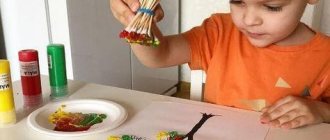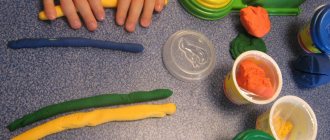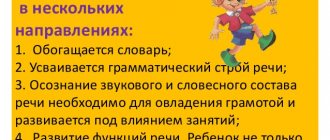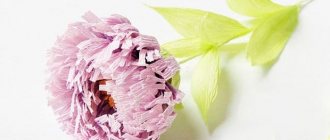Development of creative abilities in preschool children in visual arts
Everything that a person subsequently assimilates never has the same depth as everything learned in childhood.
K. D. Ushinsky
Introducing children to the fine arts and introducing them to artistic creativity begins already from preschool age, since this is one of the recognized ways of forming a personality and developing its creative potential.
Arousing interest in the world around us, realizing oneself in it, reflecting a personal impression of something, developing imagination and fantasy, cultivating emotional responsiveness, arousing children’s desire to see beauty in the world around them, forming an aesthetic attitude towards the world and much more will help the child, just like us It seems that it is artistic creativity, the development of which, therefore, should begin as early as possible.
From a very early age, children try to reflect their impressions of the world around them in their visual creativity through visual sensations. At first, the “paintings” created by the children, the so-called “doodles,” are understandable only to the “artists” themselves. At an early stage, they sometimes don't need paints, brushes and pencils. Kids draw with their fingers, palms on foggy glass, a stick on the sand, chalk on the asphalt, sometimes mother’s unattended lipstick or paste on the mirror, water spilled on the table, they make images with buttons or beads taken from their grandmother’s box. That is, everything that can leave a visible trace. At the same time, children not only reflect what they see and feel, but also get acquainted with materials and objects of different properties and qualities.
As they get older, preschoolers first acquire the simplest skills and abilities of drawing using traditional methods and means. And over time, they meaningfully seek out new techniques for reflecting the surrounding reality in their own artistic creativity. At that moment, the teacher can make this work purposeful and introduce children to non-traditional techniques that take place in the fine arts. Include the most unusual means of image in the educational process: paraffin candle, comb, toothbrush, cotton swab, thread and much more. This is a free creative process, when the word “impossible” is not present, but there is an opportunity to break the rules of using certain materials: but with your finger and paint. Carrying out such classes helps to relieve children's fears, gain faith in their strengths, internal harmony with themselves and the world around them, and will give children a new wide range of sensations that will become richer, fuller and brighter.
For our work, we choose the topic of non-traditional drawing techniques because it is interesting to both educators and our children. All of them, without exception, quickly and willingly get involved in work in class, and after completing it they react very emotionally to the result of their work - their drawing. Our students love to draw using techniques such as finger painting. Drawing in this unconventional technique brings great joy to children, liberates them and increases their self-esteem. They also like the potato signet print. Printing with signets allows children to be prepared for subsequent depictions of objects in the surrounding world from life, learning compositional drawing, and teaching them to coordinate hand movements. A poke with a hard, semi-dry brush. This method of drawing allows you to give the drawing the necessary expressiveness and realism, and the child gets pleasure from his work. Wax crayons and watercolors. This drawing technique is used to create the desired general tone or background of the picture, for example: sky, sand, water, etc. Also in our work we use such types of non-traditional drawing techniques as: monotype, blotography, spraying, scratching, batik and others.
We know that artistic abilities reveal themselves earlier than others. Children are gifted in all types of art, but they received the most lasting recognition in art, and it is not surprising, because the product of their activity - drawings - can be stored, exhibited, studied as evidence of the talent of the little author. Children have rich prerequisites for the development of not only artistic, but also creativity in general. The child has not yet built an impenetrable wall between “I” and “not I.” He is ready to treat everything as if it were alive, to see in any object and phenomenon the soul, character, aspiration - everything that is inherent in himself. The child develops his own attitude, his own understanding of the subject, it is no coincidence that even color for the baby is a means of expressing the attitude towards the subject: dark, careless tones and lines - “bad, evil, scary”; and vice versa, bright, light colors for beautiful, beloved, kind drawings. Imagination for a young artist is not ingenuity, not originality, but the ability to create a sensual image that expressively reveals the unique inner content. Gifted children often make “banal images,” but the former are distinguished not by “what” they depict, but by “how” and “for what” they do it.
One of the distinctive signs of talent in the visual arts will be the expressiveness of color schemes, non-subordination to patterns, “speaking” color; greater dynamism of the drawings. But for visual talent, more than for others, there is a certain “age-related talent” that rolls over all children, and then, in almost all of them, fades away. Of course, we understand that in children’s artistic activities important aspects of age-related development are realized, then these possibilities turn out to be exhausted and development finds another path, or the child draws haphazardly, “wrongly” - and that’s the beauty of it. We want to say that artistic activity is somewhat specific. In art there can be no assessment of “right or wrong” - otherwise there would not be a huge variety of artists, but there would be one single standard accepted as a model. Moreover, artists who go “far” from templates, from the real vision of the world are called genius: Pablo Picasso, Salvador Dali, Hieronymus Bosch. But what about the greatest painting by Kazemir Malevich “Black Square”, if we evaluate it only from the position of naturalistic illusionism - an adequate depiction of purely objective relations?
Genius is hidden not in the form, but in the deep content of the drawing, not “how” it is written, but “for what.” That is why in our work we set the primary goal of educating and developing artistically gifted children not to master graphic skills, but to develop creative activity and a non-standard vision of the world. After all, creativity is the basis of any talent.
Of course, we all know that the impressions received in the classroom are reflected in children's drawings. Therefore, we believe that the most effective principles for activating children are the following:
— saturation of material with educational visuals and musical aids
- dynamism
— interest of children and teachers
- variety of techniques and forms of activity
- emotional presentation of the material
- differentiated approach to each child
- use of age-appropriate musical accompaniment that gives an educational effect and a creative impulse.
We focus on such partial programs for the artistic and creative development of preschool children as “Nature and the Artist” by T. A. Koptseva and “The Living World of Images” by R. G. Kazakova, L. M. Danilova, etc., where the following areas of work are highlighted:
1. Development of curiosity as the basis of cognitive activity. Development of cognitive processes.
“As modern research shows (S. M. Vainerman), children’s drawing at all its stages is associated with sensory knowledge of reality, primarily with visual images... When creating an image, a child relies on his ideas about objects, and not on their direct perception "
2. Teaching methods of visual activity.
“The main condition for improving visual skills, awakening interest in visual arts, and developing creative activity was the use of a wide range of non-traditional materials in work.
3. Development of creative imagination.
“The creative activity of the imagination is directly dependent on the wealth and development of a person’s previous experience. The richer a person’s experience, the more material the imagination has at its disposal.” L. S. Vygotsky.
4. Development of communication skills. “Everything seen and heard must certainly be spoken out loud, that is, verbally express your intention. But it is necessary not only to verbally conceive, but also to briefly, figuratively summarize the plot, simply name the drawing. Speech is the first ally of drawing.” Mukhina V.S.
We believe that an individual approach to preschoolers has a positive impact on the formation of the personality of each child if it is carried out in a certain system: studying the manifestations of the child, establishing the reasons for the formation of the characteristics of his character and behavior, determining the appropriate means and methods, clear organizational forms for implementing the individual approach to each child in general pedagogical work with all children.
In conclusion, I would like to say that visual activity is especially interesting for preschoolers, as it evokes in them a feeling of joy, surprise, novelty, and admiration for the world around them. All classes are aimed at developing creativity in preschoolers and provide ample opportunities for studying the characteristics of children and implementing an individual approach to each child, which contributes to the development of not only their artistic abilities, but also attention, observation, perseverance and will. The formation of these qualities is an essential condition for preparing a child for school and for the full development of the individual.
Literature:
1. Alekhin A.D. Fine arts: Artist. Teacher. School. Book for the teacher. M.: Education, 1998.
2. Belyavsky I. G. Aesthetic perception of painting by senior schoolchildren: Abstract of thesis. Candidate of Pedagogical Sciences (psychology).1. M., 2001.
3. Issues of artistic development of schoolchildren in fine arts classes: (Collection of scientific works) / Ed. B. P. Yusova. M., 2007.
4. Vygotsky L. S. Imagination and creativity in childhood: Psychological essay. 2nd ed. - M.: Education, 2004.
5. Zhurkin A. A. Formation of students’ interest in artistic and design activities: Abstract of thesis. Candidate of Pedagogical Sciences. L., 1999.
6. Kazakova T. G. Visual activity and artistic development of preschoolers. M.: Pedagogy, 2001.
Development of children's creative abilities through unconventional drawing
All children are researchers; they are passionate about learning previously unknown things and mastering new activities. Therefore, it is useful to use unusual techniques and develop children’s creative abilities through unconventional drawing.
Imagination on paper - clicking heels
The use of unconventional techniques and techniques helps children overcome fear and uncertainty, because they are still poor at using a pencil and brush, and they do not always like their own drawings. And failures greatly reduce motivation and interest in drawing and make it difficult to develop creative abilities in visual arts.
There are quite a lot of methods that are considered non-traditional, and they are intended for children of different ages. So, for the little ones the following are suitable:
- Finger painting is very useful in early childhood, as it develops not only imaginative thinking, but also tactile sensitivity.
- Finishing the drawing of handprints is very exciting and develops imagination and imaginative thinking.
- Using a variety of prints, which allows kids to admire the beautiful prints.
- Blotography is an absolutely amazing technique. Children love her very much, looking with delight at the original paintings created from simple blots.
- Drawing with sand allows kids to master a completely unusual material.
How to depict Rustle - draw the sound




